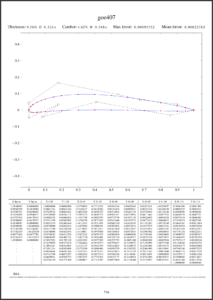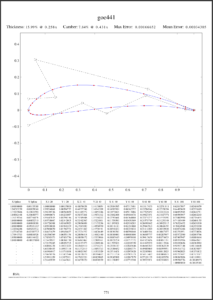Description
https://www.youtube.com/watch?v=qgBkfUzrbPk
The HAVF (Holbrook Airfoil Vector Format) library was created out of frustration from using the
conventional DAT file system as the basis to record and create airfoil shapes. Although DAT files are still great
for their simplicity, and ubiquity for use in aerospace tools, they have many problems. In this book, we will
describe a more fundamental vector format that can be used to make DAT files, or if required, be imported directly
into CAD as curves. Utilizing this method, users will be able to transfer, communicate, edit, evaluate,
simulate and replace geometry faster and at a higher quality than was possible using DAT files as a foundation
for existing airfoils. Because the format is powerful enough to describe 1500+ airfoil accurately, it is also well
suited for creating new airfoils, as well as a geometric language for airfoil, wing, or blade optimization.
This library itself as a design reference is a powerful input tool to accelerate any type of geometry optimization by
inserting the many different shapes.
This book includes:
– Detailed information on how to master the vector formats in almost any software
environment. Three methods are provided to replicate the vector format. Each method includes detailed explanations and relevant
MATLAB source code. This way, there is always a good solution for the reader to use the vector format.
– An organized page of detailed information for all 1582 airfoils included in the library
– A library of 1582 airfoils in both the HAVF, and traditional coordinate system. The coordinate exports are the highest
quality airfoil database that money can buy, with all airfoils drawn counter-clockwise in a upper TE, to LE, to lower TE fashion, with
every airfoil in the library having exactly 101 coordinates.
– A vector array at the bottom of the page that can be quickly copy and pasted from the book into design software.
– Accurate thickness and camber information for every airfoil that is written directly in the PDF. This makes searching the PDF
for groups of airfoils with similar/related qualities a breeze, and much faster than using any website.
– Accurate calculations about the maximum and average error between the vector based curve, and the orignial airfoil coordinates.
Note that some of the “original” airfoil coordinates had to have been scaled and rotated so that every airfoil is as much on
a perfect 1 to 0 scale as possible. So that every leading edge is on (0,0), and the center of every trailing edge is at (1,0).
– Tips and tricks to help you create your own tools, and take advantage of the new format. These mainly revolve around
the methods to squeeze all the usefulness out of the vector format, so that you can use it to describe the chord, AOA,
TE thickness, and airfoil of a wing, and change any of those 4 variables parametrically, without re-importing, or fixing any
of the other inputs. This amounts to a huge time save for anyone who spends any amount of time modelling in aerospace
, especially in more complicated wing and blade models.
*** Please note that this product can not by bought in bulk. The customer name will be used in checkout to
apply a watermark to the book that binds that registers that book to them. This is used as a simple and effective way to publish
our own book digitally, with the immutability of a physical paper book.





Reviews
There are no reviews yet.